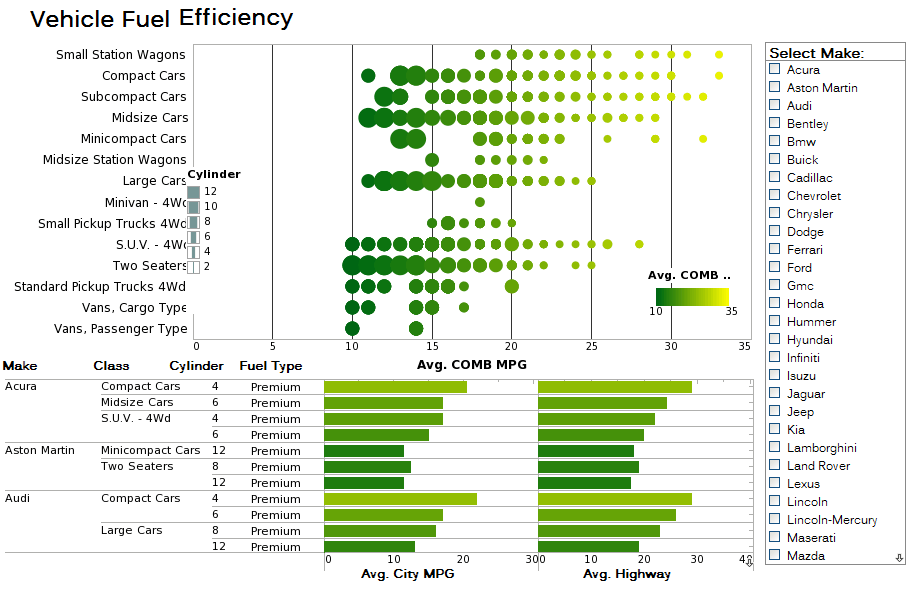Business Intelligence Without ETL or a Data Warehouse
Do you assume you need ETL tools and a data warehouse for a BI solution? Our data dashboard tools offer Web based reporting and dashboard software that accesses disparate data sources directly.
If you already have an ETL process established and running smoothly, InetSoft's Style Intelligence™ business intelligence platform can easily interact with the data in your data warehouse.
However, if you are looking to cut down on the resource and cost overhead associated with this cumbersome infrastructure and these rigid, manual processes, there is an alternative.
Or if you are just beginning to research a BI project and have read the standard BI implementation best practices that steer you towards the middle layers of ETL and data warehousing, realize that it is not necessarily the case any longer. New business intelligence software exists that can save you the investment in ETL tools and data warehouses.
Learning from Our Experience with Customers
InetSoft was founded in 1996, and over the years of delivering BI software solutions to over 3,000 customers, we have found that oftentimes organizations and enterprises struggle with the data gathering and preparation process. They spend inordinate amounts of time planning for the perfect data warehouse and customizing ETL routines to extract, transform, and load data from disparate data sources. They spend significant amounts of money adding additional hardware and software. The project swells to something much larger than they needed.
We have found that many times their requirements do not warrant that type of effort or investment. Other times, even if they might be well served by ETL and a data warehouse, their budget and staff constraints prevent them from going forward.
We learned from our customers' business intelligence project experiences and came up with a simpler way to help people to achieve their BI solution goals. We created a very robust data access engine, based on our patent-pending Data Block™ technology, that accesses disparate data sources directly. We also created the capability for data mashups which delivers significant agility advantages over the traditional ETL and data warehouse solution.
Technical Details
Key features of the Style Intelligence business intelligence platform include:
- Professional atomic data block modeling tool
- End user data mashup on the Web
- Connectivity to relational databases (JDBC), Multidimensional databases, XML, SOAP, Java beans (POJO), EJB beans, flat files including spreadsheets, OLAP servers including Microsoft SQL Server Analysis Services, Hyperion ESSbase, Oracle OLAP, and SAP NetWeaver, salesforce.com, Google AdWords and Analytics, and ERP applications such as SAP, PeopleSoft, JD Edwards, Siebel CRM, and more.
- Security control on data cell for user, role and group
- Data mashup across domain and multi data sources
- High performance, configurable column-based data cache
What Kinds of Data Transformation Can Be Done with InetSoft's Data Mashup Engine?
Some of the key data transformation tasks that can be performed using InetSoft's Data Mashup Engine include:
-
Data Integration: The Data Mashup Engine allows users to integrate data from disparate sources, including databases, spreadsheets, web services, and cloud-based applications. Users can easily connect to these data sources and consolidate data into a unified dataset for analysis and reporting.
-
Data Cleansing and Quality Assurance: InetSoft's Data Mashup Engine provides tools for cleansing and standardizing data to ensure accuracy and consistency. Users can perform tasks such as removing duplicate records, correcting errors, and validating data against predefined rules to improve data quality.
-
Data Aggregation and Summarization: Users can aggregate and summarize data using the Data Mashup Engine to create meaningful insights and reports. This includes tasks such as calculating totals, averages, and other summary statistics, as well as grouping data into categories for analysis.
-
Data Transformation and Manipulation: The Data Mashup Engine supports a wide range of data transformation and manipulation functions, allowing users to reshape and restructure data to meet their specific requirements. This includes tasks such as filtering, sorting, pivoting, and joining datasets, as well as applying mathematical calculations and conditional logic to transform data values.
-
Data Enrichment: Users can enrich their data by combining it with external datasets or adding additional information from external sources. This may include tasks such as geocoding addresses, appending demographic data, or integrating third-party data sources to enhance the depth and context of analysis.
-
Time-Series Analysis: InetSoft's Data Mashup Engine supports time-series analysis, allowing users to analyze and visualize data trends over time. Users can perform tasks such as date and time calculations, rolling averages, and trend analysis to identify patterns and anomalies in time-series data.
-
Data Normalization and Denormalization: Users can normalize or denormalize data structures to optimize data storage and retrieval efficiency. This includes tasks such as breaking down complex data structures into simpler forms for analysis or combining multiple datasets into a single denormalized dataset for reporting purposes.
-
Data Validation and Error Handling: The Data Mashup Engine provides robust capabilities for data validation and error handling to ensure the integrity and reliability of analysis results. Users can define validation rules, handle missing or erroneous data, and implement error detection and correction mechanisms to mitigate data quality issues.


